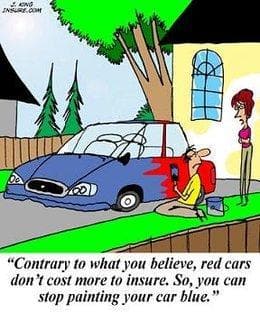Insurance policies can be complicated enough. Don’t let a flood of misinformation drown out the facts. Since confusion can be costly, here are the most common car insurance myths debunked.

Fact: Red will not cost you more green. Roughly 25 percent of drivers surveyed by Progressive Insurance believe that the color of their car is a factor in determining their insurance rate — especially if the car is red. But the belief that drivers of red cars pay higher car insurance premiums is a myth. Insurance companies will likely not even ask the color of your car when they’re calculating your car insurance quote.
"The idea that the color of a car enters into what you’re going to pay for insurance is a myth that’s been around for a long time," says Jeff McCollum, spokesperson for State Farm Insurance. "I wouldn’t be surprised if it came from the fact that people with red sports cars have the image of being wild and reckless, but it certainly isn’t based on any type of reality."
Car insurance companies are interested in the year, make, model, body type, engine size and age of your vehicle. The color may be important to you, but it really doesn’t matter to your insurance company.
Fact: It’s the other way around. Statistics show that thieves actually prefer to steal older cars. According to a 2008 National Insurance Crime Bureau (NICB) report, the top 10 most-stolen vehicles reported in 2007 were the ‘95 Honda Civic, ‘91 Honda Accord, ‘89 Toyota Camry, ‘97 Ford F-150 pickup, ‘94 Chevrolet C/K 1500 pickup, ‘94 Acura Integra, ‘04 Dodge Ram pickup, ‘94 Nissan Sentra, ‘88 Toyota pickup and ‘07 Toyota Corolla.
"The reason we see so many older vehicles on the list is because they are easier to steal," says Frank Scafidi, spokesperson for the National NICB. "Also, people are keeping their cars longer (in the faltering economy). That creates a good market for used parts. A lot of times, when they are stolen, they don’t make it back on the street intact."
If you have an older vehicle and have dropped comprehensive coverage to save money, you are not covered for theft and do not qualify for rental car coverage. NICB’s report reveals that thieves have different preferences from state to state. Crooks in California and Florida prefer imports like Hondas and Toyotas. Texas crooks select pickup trucks. Criminals in Illinois, Indiana and Michigan have a thing for domestics (Dodges and Fords).
Fact: Unless you have comprehensive coverage, you are not covered for any of these things. A bare-bones policy in most states only requires you to buy liability coverage. This pays only for damage you cause to others. You need to purchase both collision and comprehensive coverage in order to fully protect your vehicle from all types of damage situations.
Comprehensive coverage covers pays for damages to your car that are not the result of a car accident. That includes theft, vandalism, hail, fires and accidents involving animals. Collision coverage pays for damage to your vehicle from a car accident.
Fact: When your car is totaled, your policy does not promise to pay off what you owe. It will pay you the actual cash value of your car, minus your deductible. Actual cash value is the amount your car was worth before the accident, factoring in depreciation. You are still responsible for any amount outstanding on the loan or car lease.
The only way to cover the difference between the car's cash value and the amount you owe on a loan is to purchase gap insurance. Available to cover both auto leases and loans, gap insurance covers you if your car is totaled before you’ve paid off the loan, or before the lease term expires. Here’s how tosave yourself some grief: buy gap coverage.
Your insurer will decide if your car is "totaled." Generally a total loss is declared when the repair costs exceed a certain threshold of the car’s value, generally 70 percent. At that point, the insurance company will tow the car to the salvage yard and offer you the actual cash value of your car.
Fact: Even if you have comprehensive and collision coverage, it may not include a rental car. Rental car reimbursement is not automatically included in most car insurance policies, but you can add it at an affordable cost. According to the Insurance Information Institute, rental reimbursement coverage is available for $1 to $2 a month with most insurers.
Even if you have this coverage, it won’t necessarily last until your stolen car is recovered or your damaged car is fixed. There’s a limit on how much your insurance company will reimburse you per day, plus a cap for a maximum amount per accident. For example, GEICO charges $20 per year for a maximum $750 in rental reimbursement, with no deductible to pay. In this case, GEICO would reimburse you up to $25 per day but no more than $750 per accident.
Fact: That’s not necessarily the case. According to a study released in 2009 by Quality Planning Corp., leading the pack with the most violations are drivers of the Hummer H2/H3. Hummer drivers have almost five times the number of violations compared to the average. Drivers of three different Scion models (tC, XB Station, XA) also made the Top 10 list. Others on the list include drivers of two models of the Mercedes-Benz (CLK63 AMG, CLS63 AMG), two Toyotas (Solara, Matrix) and the Subaru Outback Station Wagon and Audi A4.
At the other end of the spectrum, the study also includes a "well-behaved vehicle list." Topping that list are drivers of the Jaguar XJ, followed by the Chevrolet Suburban, Chevrolet Tahoe, Chevrolet C/K-3500/2500, Buick Park Avenue, Mazda6, Buick Rainier, Oldsmobile Silhouette, Buick Lucerne and GMC Sierra C1500 pickup truck.
While insurers don’t base their rates on this particular study, the type of car you drive and your driving history factor into how much you will pay for car insurance. Label: car insurance, cheap car insurance, insurance, myths, top car insurance




















